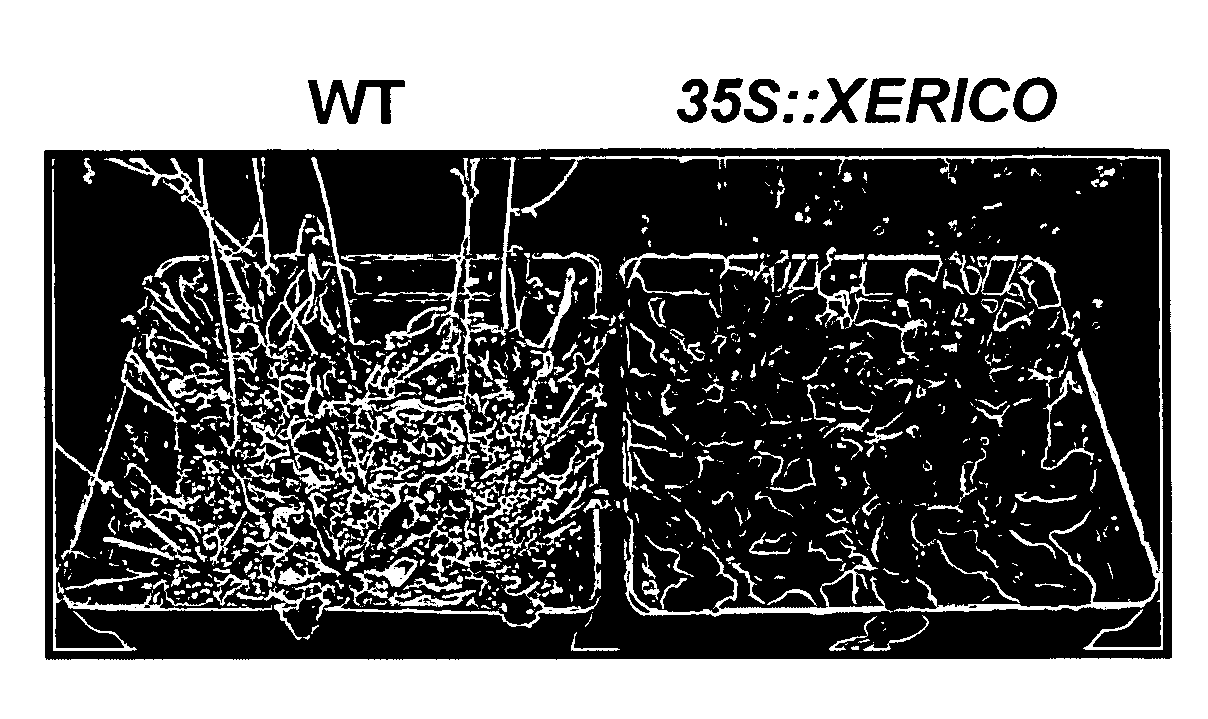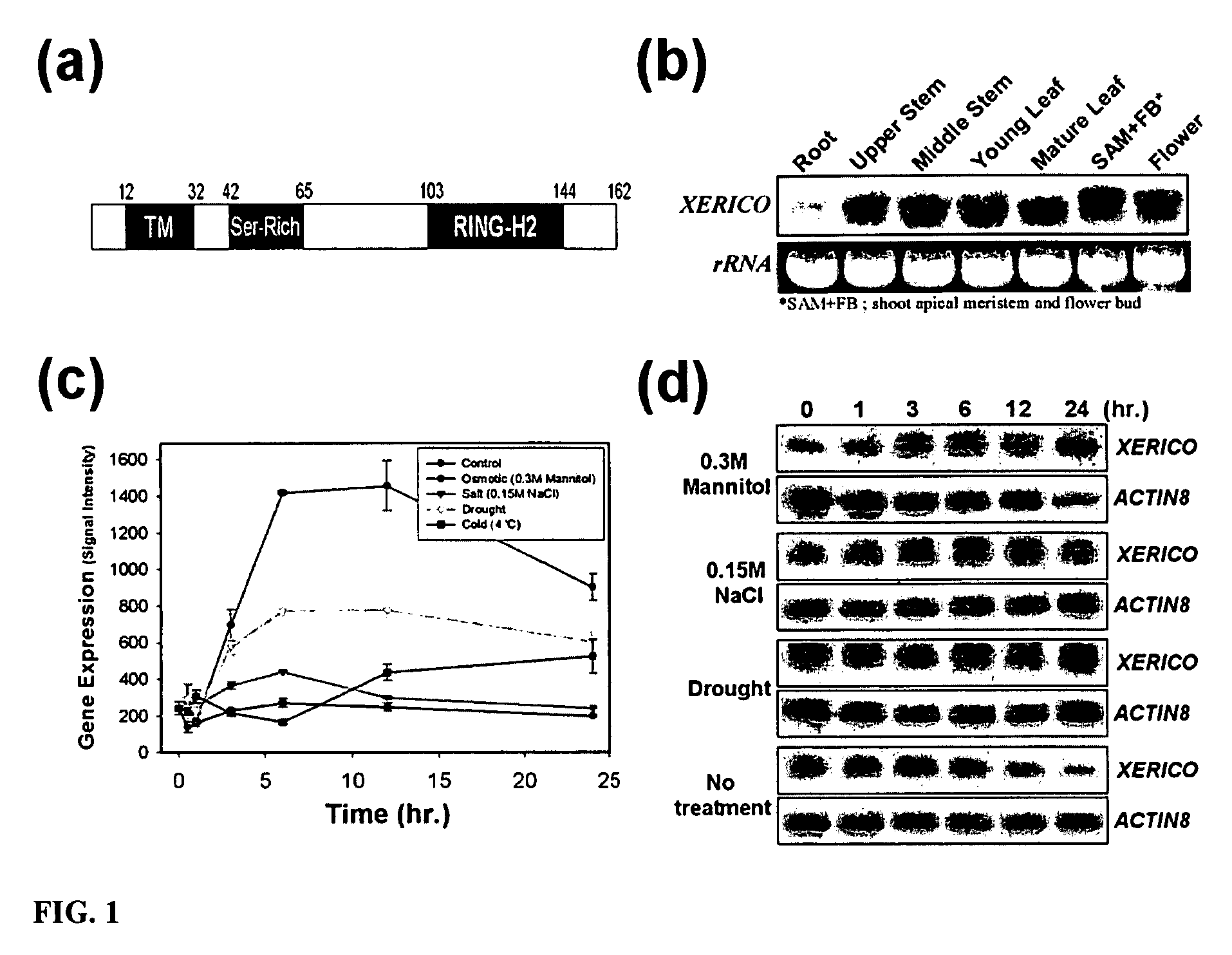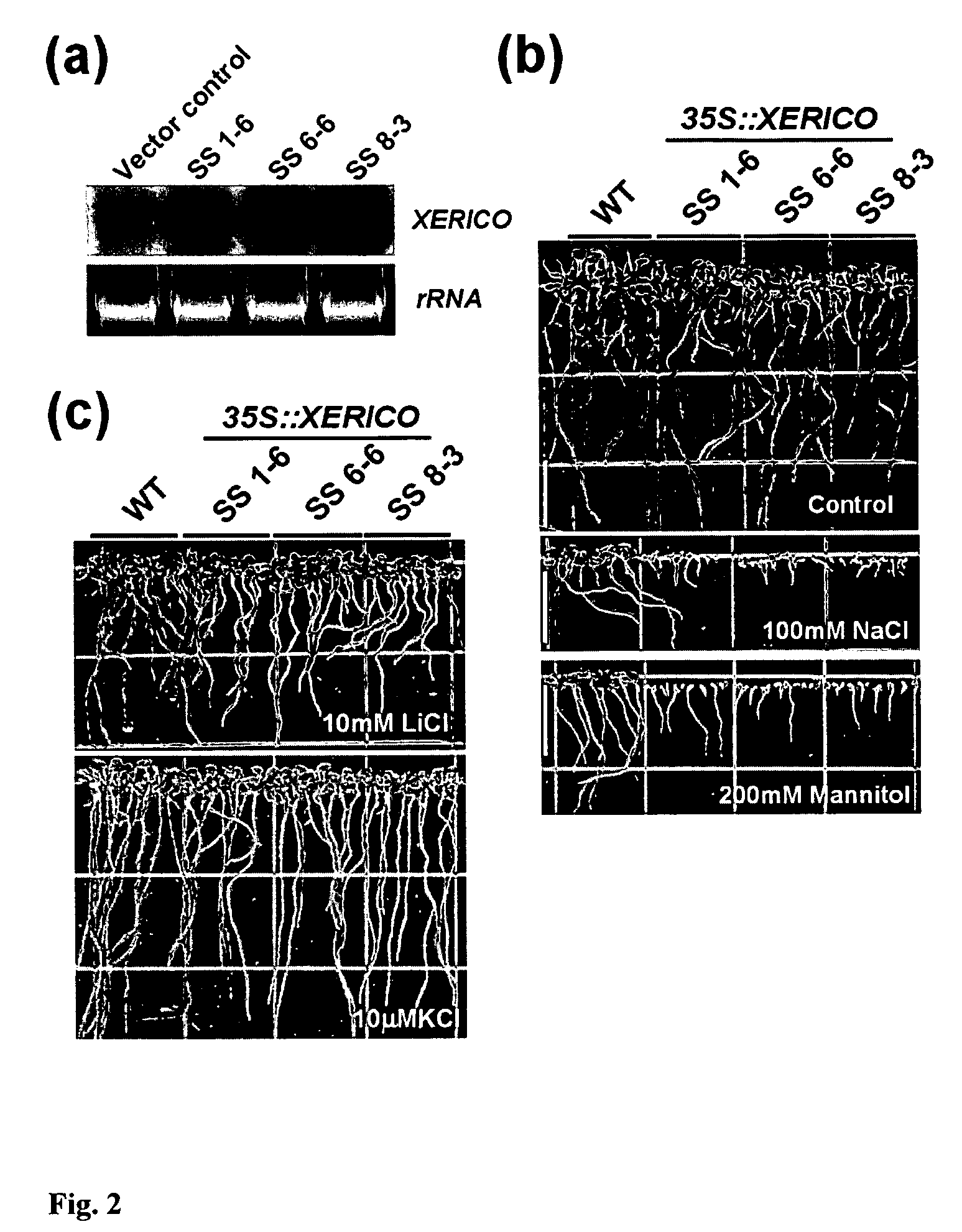DNA encoding ring zinc-finger protein and the use of the DNA in vectors and bacteria and in plants
a zinc finger and transcription factor technology, applied in the field of stress-tolerant transgenic plants, can solve the problems of ineffective conventional crop improvement for enhanced drought tolerance, difficult identification and characterization of plant genes that confer drought tolerance, and limiting plant productivity and spatial distribution, etc., to achieve the effect of low complexity, and increasing the tolerance to abiotic stress in a plan
- Summary
- Abstract
- Description
- Claims
- Application Information
AI Technical Summary
Benefits of technology
Problems solved by technology
Method used
Image
Examples
example i
Materials and Methods
Experimental Procedures
Plant Materials and Growth Conditions
[0252]Arabidopsis thaliana, ecotype Columbia (Col), was used as the wild-type plant for phenotypic assays for comparison to transgenic 35S::XERICO Arabidopsis thaliana, plants in these experiments. Unless noted otherwise, plants were grown under sterile conditions on MS nutrient agar media (1×MS basal medium (Sigma, stock number M5519) with 2% sucrose and 0.3% phytagel (Sigma) containing 2% sucrose or on soil in a growth chamber (16 h light / 8 h dark) at 23° C., after stratification. For monitoring of hypocotyl elongation and root growth with response salt / osmotic stress, a minimum of 20 seeds were sowed on MS nutrient agar media containing specified treatments, following which the plates were held in the vertical position for 7 days. For testing the effects of ABA on germination and early seedling growth, seeds were grown horizontally. For abiotic stress treatments, wild-type seedlings were grown on MS ...
example ii
Transgenic Plants Over-Expressing XERICO Demonstrated Hypersensitivity to Salt and Osmotic Stress During Germination and Early Seedling Growth
[0260]XERICO (At2g04240; SEQ ID NO:02) is a single copy gene in the Arabidopsis genome that encodes a small protein (162 amino acids; SEQ ID NO:01) with an N-terminal transmembrane domain (SEQ ID NO:09), a RING-H2 zinc-finger motif located at the C-terminus (SEQ ID NO:3), and a serine-rich domain in the middle (SEQ ID NO:08) (FIG. 1a). XERICO is expressed ubiquitously in the plant, but its transcript is accumulated more in the actively growing tissues (FIG. 1b). Using Affymetrix GeneChip array data available on the AtGenExpress website (AtGenExpress, http: / / web.uni-frankfurt.de / fb15 / botanik / mcb / AFGN / atgenex.htm), transcriptional regulation of XERICO was examined at various aspects of plant growth and development, including during plant hormonal and environmental stress responses. The information obtained showed that salt and osmotic stress con...
example iii
Transgenic Plants Over-Expressing XERICO Demonstrated Hypersensitivity to Salt and Osmotic Stress During Germination and Early Seedling Growth
[0261]Transgenic Arabidopsis plants over-expressing the gene (35S::XERICO) were created during the course of the present inventions. See, EXAMPLE I for methods. Fifteen out of 18 over-expression transgenic lines showed similar phenotypes such as short hypocotyl, round-shaped rosette leaves, ABA hyper-sensitivities of early seedling growth. Of these 15 lines, three T3 homozygous lines (SS1-6, SS6-6 and SS8-3) were used for further phenotypic characterizations based on their XERICO expression levels (FIG. 2a). The early seedling growth of all of the tested 35S::XERICO plants was hypersensitive to both salt and osmotic stresses, compared to wild-type plants (FIG. 2b). To address whether the observed sensitivity of the 35S::XERICO plants is from a defect in potassium uptake for osmoregulation, effects of both LiCl treatment, an inhibitor of potass...
PUM
| Property | Measurement | Unit |
|---|---|---|
| Fraction | aaaaa | aaaaa |
| Fraction | aaaaa | aaaaa |
| Fraction | aaaaa | aaaaa |
Abstract
Description
Claims
Application Information
 Login to View More
Login to View More - R&D
- Intellectual Property
- Life Sciences
- Materials
- Tech Scout
- Unparalleled Data Quality
- Higher Quality Content
- 60% Fewer Hallucinations
Browse by: Latest US Patents, China's latest patents, Technical Efficacy Thesaurus, Application Domain, Technology Topic, Popular Technical Reports.
© 2025 PatSnap. All rights reserved.Legal|Privacy policy|Modern Slavery Act Transparency Statement|Sitemap|About US| Contact US: help@patsnap.com



